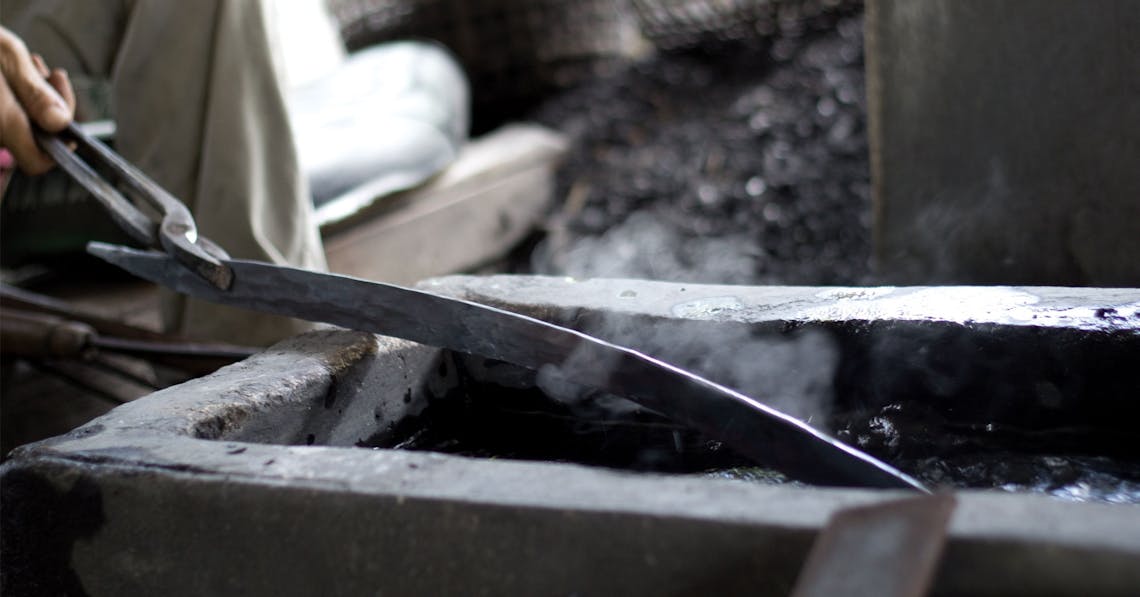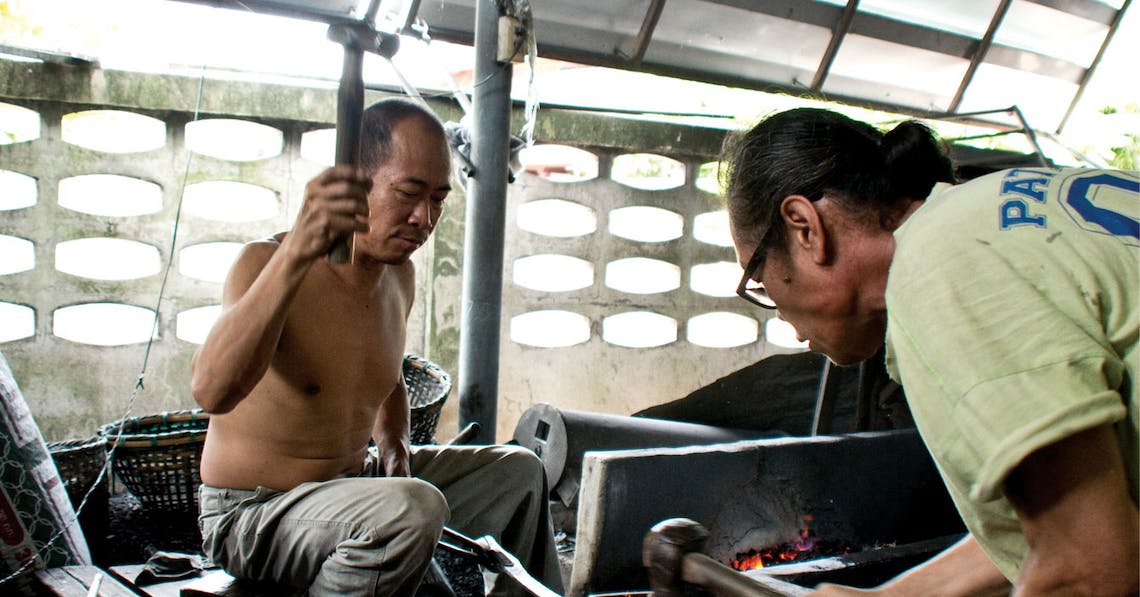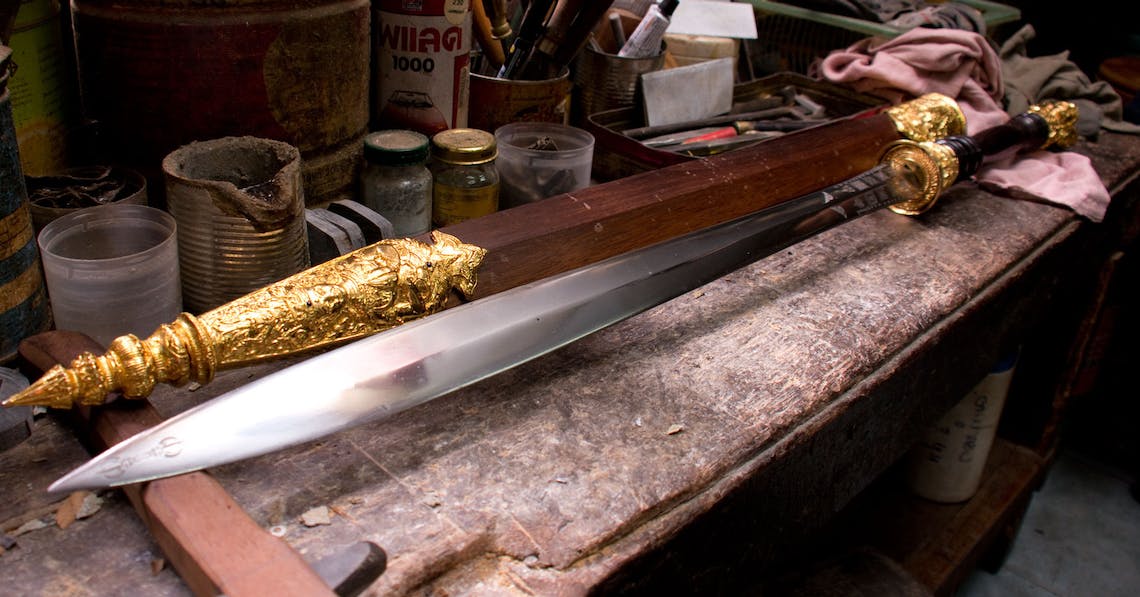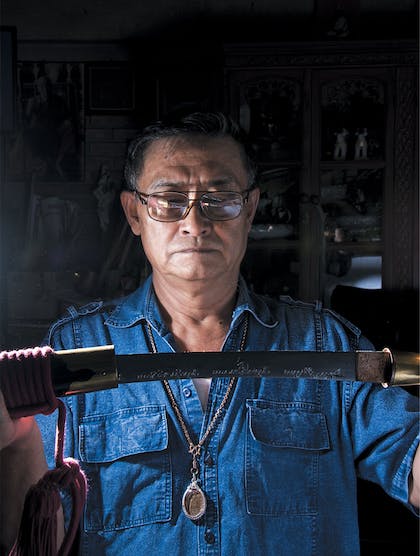I drive around the suburb of Hang Chat in Lampang, stopping every few minutes to ask another person to point me towards the town’s sword maker. Down a rural road, past a Tesco Lotus sign, some noodle shops, and a field of horses, I find a sign that reads “Hit the Knife Group Station.” It is the shop and home of Bunthun Sitthipaisan, one of Thailand’s last and most renowned sword makers.
His shop is unassuming for a man who has made swords for the King of Thailand. The space is cluttered with weapons and tools. It’s like stepping into an archaic attic, and the promise of treasures is quickly sated.
The craft of sword making is a dying one, and Bunthun is one of the last men to pass this tradition on to the next generation. He is one of the few people still making the dah, a Burmese word that means “blade”, which represents a long history of sword making across Indochina. This part of the world has a tradition of sword use, for warfare, as practical tools, and ceremonially.
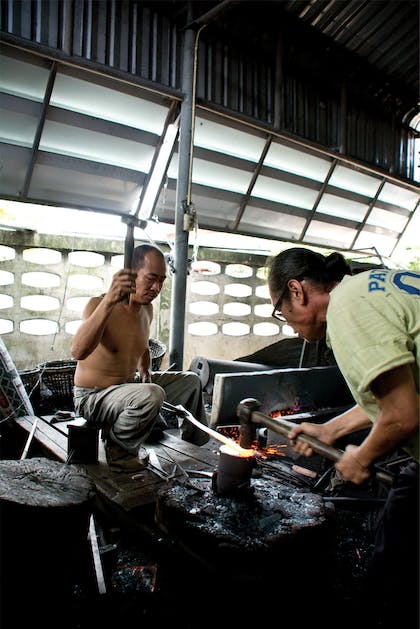
There are indications that the dah, also known as the “daab” or “darb” in Thai, was in use in Thailand by the Ayutthaya period (1350-1767 C.E.). Weapons were a part of everyday life, and swords were later incorporated into ceremonial dances, physical education classes, and martial arts. Ceremonial dance and mock fighting came together in Thailand in Krabi Krabong, “sword and staff,” which is a style of fighting based on various weapons systems that was formalised in 1936 as part of the curriculum of the College of Physical Education under the title “Folk Arts.”
The design of the dah varies, but it is generally long and curved, with a single-edged blade, and a round wooden hilt that is often rattan or metal. It has been depicted on the walls at Angkor Wat and used by Kachin tribesmen who were recruited by the Allies during WWII to protect the “Burma Road.” Its origin is unknown and difficult to trace. It may have travelled with the Burmese as they moved southeast from India, from the Tai people when they moved southwest from Yunnan China, or from the Khmer people prior to that.
The whir of tools plays in the background as I sit with one of the last dah craftsmen. Bunthun is sixty-eight years old. He wears black-rimmed glasses, a clean white tank top, and a gold Buddha chain. His speech is measured and jovial. He laughs easily, and his charm and playfulness cut through our language barrier.
Bunthun grew up in Hang Chat, with seven siblings. He left school at twelve years old. It was too expensive, and he told his father that at twelve years old “he was already a grown up.” He borrowed money from his father, began a small rice mill, and learned to make swords from the owner of the house whose land he rented for his mill. The owner made agricultural knives. These knives were made with a low quality steel and were physically exhausting to make. Bunthun experimented with other types of knives. He has now made knives and swords for over fifty years, and sells his wares for at least ten times what he would earn from his agricultural knives.
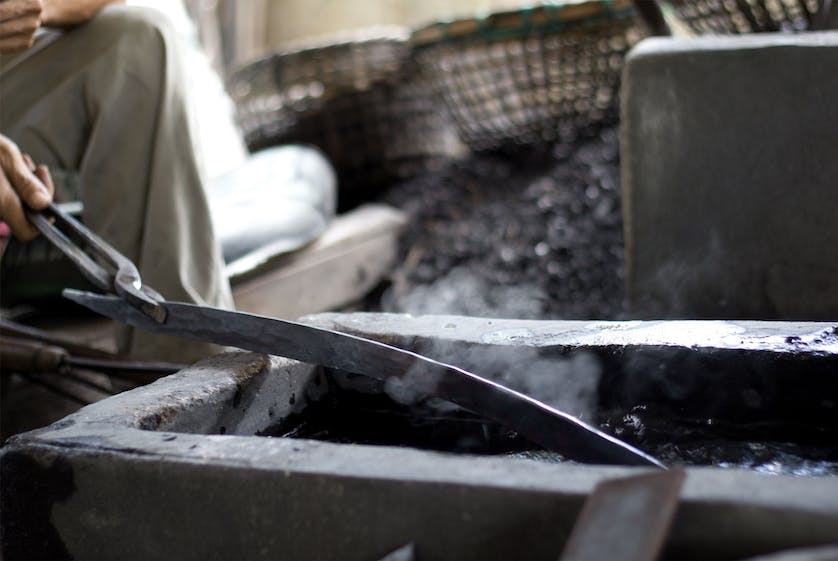
In 1962, when he was fifteen years old, he began exporting knives to Lao and Cambodia. People from these countries had visited Thailand to worship Buddha’s footprints in Lop Buri province and had heard about the source of these knives. Merchant middlemen bought ancient swords like the Dab Bai Khao, Dab Bai Ka, and Dab Hua Bua and brought them back to their home countries. When business slowed, Bunthun moved to Saudi Arabia and worked as a wooden furniture maker.
After ten years, he returned to Hang Chat and went into business with the Japanese. For twenty years, they brought steel from Japan and he designed samurai swords for them.
“The Japanese swords are better. They have a better quality of metal, it is stronger and slicker,” he said. He takes out the various Knives and presents them to me: carving knives, dagger-shaped knives, hooked, loveless, Bowie, and Putin knives, and the Ngam Ngai sword used for sword dancing.
Business wasn’t always good. “Some people might say I was stingy. But I had my own goal that needed to be achieved,” he said. “Some people I know, they spend money frivolously as soon as they receive money instead of paying their debts. They are doing it wrong. The first thing they need to do is fill the cracks. People are like woven baskets full of holes; if they don’t seal the cracks, they cannot fill with water,” he said. When Bunthun started, he invested 300,000 baht and took a 1,000,000 baht loan from the bank, which he paid off in two years. Now he says he has invested three million baht in total.
It takes a week to make most of his swords. They cost 2,000 baht to produce and are sold at 3,200 baht. Samurai swords require two weeks and 30,000 baht and are sold for over 42,000 baht. Silver swords take the longest, about six months, because of their intricately carved patterns. The silver pieces sell for 68,000 baht.
Now, business is good. He exports his products to Germany, France, Switzerland, Singapore, and Malaysia. Businesses from these countries find examples of his swords online and request them. Some import Thai swords, others provide designs for him to recreate and he modifies them to make them easier to hold. Bunthun says he has recognised some of his swords and knives in films, but has not been given credit. He would like the filmmakers to give him credit so that he can promote his country through his work.
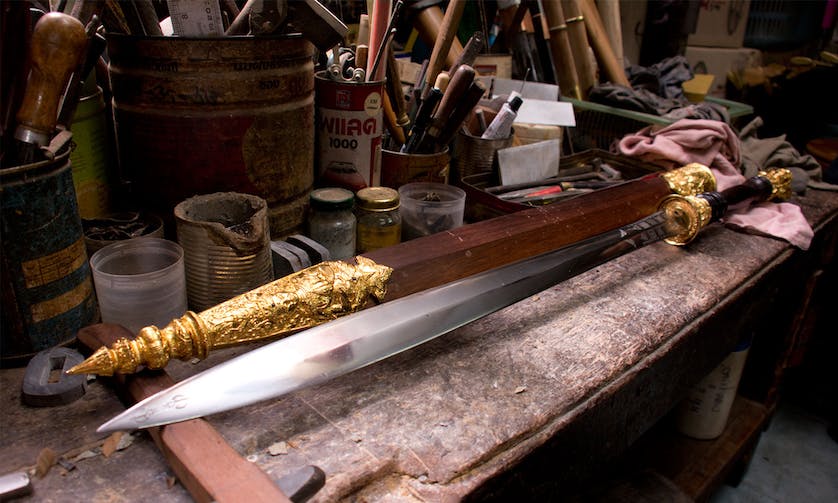
Employees used to leave him because he didn’t have much money to pay them. Now he doesn’t hire employees; he hires “co-workers.” He trains and mentors them. He will teach anyone who wants to learn to make a sword for free. It takes one week to learn the process of forging, hammering, shaping, cleaning, and sharpening the blade, along with crafting the handle and sheath. Once they are skillful, if they choose to stay, they all share in the profits. He has ten craftsmen who earn 28,000-30,000+ baht a month. The more skillful they are, the more they earn.
Bunthun’s craftsmen finish about ten swords each day. “It’s about quality, not quantity,” he said. “It is a dangerous job to make swords by hand and not machine, especially when we iron the metal. We cannot overproduce. Craftsmen need to be calm and concentrated, to work alone in a quiet space, and to focus on every hit of the sword.” From their attention to quality, their reputation has grown. While they practice an endangered art, Bunthun continues to pass on this ancient craft to the next generation in hopes that it will not die.
Contact Bunthun at 089 3718482, 054 338482.

